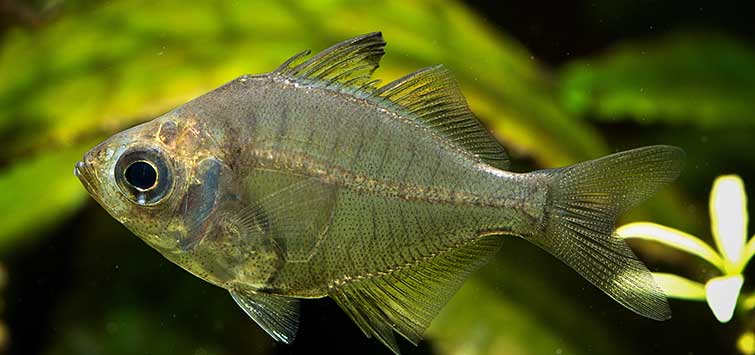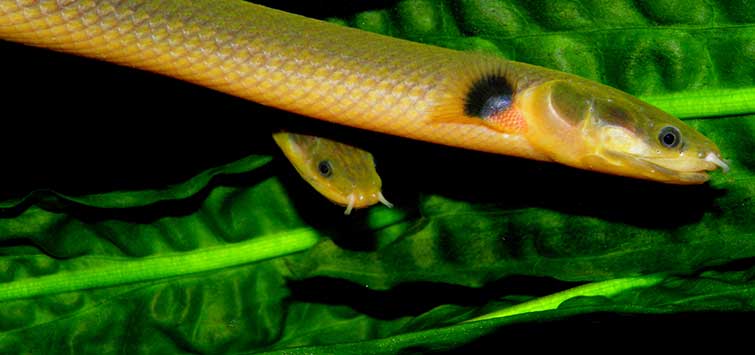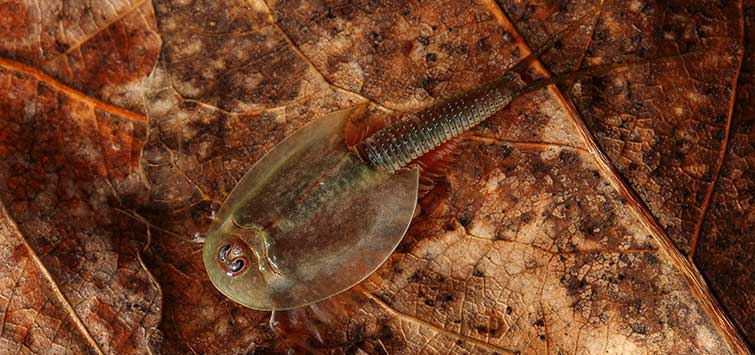Mission Impossible? The Search for the Community Tank Oddball
Cue dramatic music. The scene: your local tropical fish store. Your mission, should you decide to accept it: adding one or more oddball species to a standard community tank.
As colorful and entertaining as the standard community fishes such as barbs and tetras may be, aquarists often have an interest in adding oddball species to their collections to add a little character. Oddballs are those fishes that don’t fall into the main aquarium fish groups like the cichlids or catfish. The problem is that, while obtaining these oddballs isn’t difficult, looking after them turns out to be a lot more of a challenge. Some grow too large to be comfortably housed in the average community tank, while others are predatory and will turn on their tankmates once they get hungry. A few place special demands on the aquarist in terms of water chemistry requirements, while others are simply difficult to maintain in captivity.
Community Tank Oddballs
Let us review our dossier of special agents, and pick the ones best suited to this mission!
Code name: Colomesus asellus
Alias: South American puffer
Origin: South America
Special Skills: Lively, peaceful, attractively colored, small size, easy to keep
Potential Flaws: Potential fin-nipper, fast-growing beak may need trimming
Most of the commonly traded pufferfish are brackish-water species, such as the figure-8 puffer Tetraodon biocellatus, but the South American puffer is a true freshwater species that has proven to be very adaptable and generally easy to keep. Water chemistry is of no great importance, but water quality is, and like all pufferfish, this is definitely a species for the mature aquarium.
These fish are outstandingly colored, with pure white bellies and alternating green and black bands on the back and sides. The eyes are large, golden, and very expressive, and part of the charm of this species (and of pufferfish generally) is the sense that they are alert, intelligent animals that watch what is going on outside the aquarium just as much as they like to explore the insides of the tank. Indeed, the best conditions for these fish include plenty of swimming space and a complex habitat with plants and rocks for them to explore.
South American puffers are the pufferfish most consistently put forward as suitable for the community aquarium. Certainly, they are neither piscivorous nor territorial, something that cannot be said about the other freshwater puffers. They are usually seen about 2½ to 3 inches in captivity, though they can reach nearly twice that length. On the other hand, they will nip the fins of slow-moving fishes kept with them—livebearers, angelfish, gouramis, and Corydoras catfish seem to be especially vulnerable. Fast-moving tetras and barbs seem to be ignored though, as are retiring catfishes that simply stay out of reach most of the time, such as suckermouth and upside-down catfish.
A bigger problem with South American pufferfish is the rate at which their teeth grow. In the wild their diet contains lots of tough prey, such as snails, and these wear down the teeth over time. But in the aquarium they are often given much softer foods like bloodworms, and as a result the teeth can become overgrown. Trimming the teeth with cuticle clippers is possible, but obviously this is a delicate process when a fish this small is the subject. The regular feeding of snails is essential if you want these fish to receive their dental work the way nature intended!
Code Name: Parambassis ranga
Alias: Glassfish
Origin: South and Southeast Asia
Special Skills: Beautifully transparent, very lively, highly adaptable
Potential Flaws: Fussy at feeding time, sometimes only sold “painted”
Glassfish are small, highly transparent fish found in fresh and brackish water. Although there are many species—all of which look pretty similar—the ones normally offered for sale are Parambassis ranga and Parambassis siamensis. For all practical purposes they can be treated as the same fish, being essentially identical in terms of size, requirements, and behavior, and the trade often makes no attempt to distinguish between them at all.
Taxonomic complexities aside, glassfish are simply charming fish. They are very alert animals and will quickly learn to wait at the front of the tank and beg for food. Glassfish are sociable and best kept in groups of six or more, but they aren’t exactly schooling fish. Instead, they tend to stay apart from one another except for periodic chases where one fish seems to try to assert its dominance over another. Maximum size is about 2 inches or so. While livebearer fry will be eaten, that is about the extent of their predaciousness, and they can be kept with fish as small as cardinal tetras without problems.
Glassfish are not fussy about water chemistry, though like other Southeast Asian freshwater fish, not-too-hard water with a slightly acidic to neutral pH is preferred. Feeding glassfish is much more problematic because they show little interest in flake foods. Live bloodworms, daphnia, and brine shrimp are readily accepted, but they can be easily weaned onto frozen substitutes as required. Frozen lobster eggs (sold for use with marine invertebrates) are a favorite food. Once settled in, glassfish will also eat small chunks of prawn, mussel, and white fish. Because they are so fast and agile, these fish have little difficulty competing with other species at feeding time.
Finding unpainted glassfish can be tricky, but please don’t buy the painted ones. Besides the cruelty involved in “tattooing” them with luminous dyes, such glassfish are more prone to diseases, making them a poor investment.
Code name: Gnathonemus petersii
Alias: Elephantnose
Origin: West and Central Africa
Special Skills: Electric sense, high level of intelligence, sensitive barbel on the chin
Potential Flaws: Highly territorial, difficult to feed, active mostly at night, responds poorly to certain medications
Elephantnoses are probably the most widely traded of the family Mormyridae; the only other species you are likely to encounter are the various species of Pollimyrus sold as “baby whales” and the “freshwater dolphins,” which could be any one of several species in the genus Mormyrus. None are particularly easy to keep for a variety of reasons.
Larger species, including Gnathonemus petersii, tend to be territorial when kept in small numbers and in the confines of a home aquarium, even though they are normally schooling fish in the wild. All are sensitive to poor water quality and exhibit a marked intolerance of copper-based medications such as those widely used to treat whitespot and fungal infections. Providing them with enough food is also a problem because mormyrids prefer live foods, particularly small worms and insect larvae, and show little interest in dried foods and flakes, at least to begin with. The ideal conditions for most of these fish is a large, dark aquarium with a soft, sandy substrate where they can forage free from competition from other nocturnal species such as loaches and catfish.
One of the reasons the elephantnose remains popular despite these shortcomings is its bizarre appearance. It is a large fish (around 12 inches), dark gray to black in color with a couple of off-white vertical bands running between the dorsal and anal fins. The tail fin is very deeply forked and borne by a long, slender “stalk” that contrasts with the depth and sturdiness of the rest of the body. The mouth is very small and almost circular, and there is a long mobile barbel on the chin that the fish uses to root about in the sand. The eyes are small but their hearing is exceptionally well developed, and like catfish they are easily startled by loud noises outside the aquarium.
Elephantnoses prefer to feed at night, using their electric sense as a sort of radar system, allowing them to navigate between objects and to communicate with one another. Although invisible and inaudible to us, they use this electrical mode of communication to offer threats to rivals, maintain their position in the hierarchy, and attract mates. Controlling all of this is a remarkably large brain, and many aquarists have learned that these fish can become tame and even appear to display true play behaviors of the sort associated with more “advanced” animals like birds and mammals, which is very unusual among fish.
Code Name: Macrognathus siamensis
Alias: Peacock spiny eel
Origin: Southeast Asia
Special Skills: Eel-like shape, peaceful, attractively colored, very adaptable
Potential Flaws: Largely nocturnal, needs sand for digging, difficult to feed, great escape artist
Many aquarists have a fondness for eel-shaped fish, but unfortunately most are rather large, highly predatory, or difficult to maintain. One exception is the peacock spiny eel, a regular feature of imports from Southeast Asia, often erroneously being sold as Macrognathus aculeatus, an entirely different species.
The peacock spiny eel can grow as large as 12 inches in length, but rarely does so, seemingly getting to a little over half that size in captivity. Given the peacock spiny eel’s size and predatory nature, it should be no surprise that small fish such as neons will be viewed as food, but mid-size tankmates are ignored completely. It is an adaptable species in terms of water chemistry, but like all spiny eels it demands excellent water quality. Unusually for a spiny eel, the peacock doesn’t seem to exhibit any animosity towards others of its species, and in fact does better when kept in groups, tending to be much less shy.
In common with the other small spiny eels, the peacock is an enthusiastic digger, and this can be a problem. When kept in tanks with a gravel substrate, the eels invariably scratch their delicate skins, and eventually opportunistic fungal and bacterial infections set in. These can be difficult to treat, and eventually the poor eel dies. Prevention, rather than remedy, is the key, and these eels should only be kept in tanks with a soft, sandy substrate—silica sand or non-calcareous black sand is ideal.
Peacock spiny eels will leap out of open tanks given the chance and so should only be kept in tanks with a tight-fitting hood. Floating plants also seem to do an admirable job of providing shade and security, encouraging the eels to swim about during the daytime, making them much easier to observe.
The other major problem with spiny eels is feeding—they are not scavengers! Earthworms, tubifex worms, and insect larvae such as bloodworms are especially relished, and it is important to offer these at night when the eels are naturally more willing to feed. They are slow feeders and should not be kept with catfish or loaches likely to steal the food before the eels even find it.
Code Name: Pantodon buchholzi
Alias: African butterflyfish
Origin: West and Central Africa
Special Skills: Beautifully camouflaged, very butterfly-like when viewed from above, essentially peaceful
Potential Flaws: Skilled jumper, easily escapes uncovered tanks, predatory, tricky to feed
The African butterflyfish is one of the most regularly traded oddballs on the market. Typically reaching around 4 inches in length, these fish are confirmed predators and will eat small fishes such as neon tetras, guppies, and zebra danios, though they are perfectly safe with bigger fish like gouramis and angels.
In the wild they feed primarily on insects that they detect within a relatively small area around the head; vibrations and eye-catching movements attract their attention, and once located the prey is quickly snapped up. Anything outside of this “kill zone” is basically ignored, and this is what makes these fish difficult to slot into the community aquarium—they just won’t swim up to pellets and flakes and eat them in the same way as other surface-dwellers like hatchetfish and livebearers.
To begin with, live foods such as mosquito larvae and mealworms should be used. Once settled in, they normally accept frozen substitutes such as bloodworms, carefully placed directly in front of the head. Some specimens eventually take flake and pellet foods as well.
African butterflyfish inhabit weedy backwaters and ponds, where they are most commonly found hidden among the plants, becoming active primarily at dawn and dusk. While they rely primarily on their excellent camouflage to avoid predators, they are able to make a quick getaway by leaping out of the water and gliding for short distances using their enlarged pectoral fins, so don’t keep these fish in an uncovered aquarium.
Breeding in home aquaria is possible but difficult, not least of all because these fish are sometimes territorial with one another (and potentially other surface dwellers, too). The two sexes can be distinguished by the shape of the anal fin (the male fish has a curved edge to the fin, whereas that of the female is straight). Soft and acidic water is essential for breeding. Over 100 floating eggs are produced; these hatch within one or two days, and the resulting fry are difficult to rear, requiring tiny live foods. One last thing: the long, trailing fins that help these fish blend in with their surroundings have a magnetic attraction for fin-nipping fish like tiger barbs and serpae tetras. Only keep African butterflyfish with non-nippy species.
Decision Time
After reviewing our dossier of agents it seems, in considering the pros and cons of each, that the ideal oddball fish for the community tank is the glassfish. Its small size, lively behavior, and all-around adaptability make the glassfish the most easily accommodated oddball in the batch.
This isn’t to say that the other fish mentioned here can’t be kept in community tanks—they can, you just have to choose tankmates with care. South American puffers would work well in an aquarium with silver dollars and a pleco, but are less well kept alongside Corydoras and angelfish. The African butterflyfish is a fascinating addition to a spacious aquarium alongside peaceful barbs, catfish, characins, and gouramis of similar size, but it will need to be given a certain amount of special care at feeding time. The spiny eel and elephantnose could both work well in any community of mid-size species, with the proviso that they are the only bottom-dwelling fish in the tank. With these two species, feeding is a problem, and anything likely to steal their food shouldn’t be added to the tank.
There are, of course, many more oddball fish available other than the ones mentioned here. Oddballs are what Martha Stewart would call “accent pieces” that draw the eye to the aquarium while immediately setting it apart from more mundane community tanks. But these are fish, not objets d’art, so before buying any fish you don’t immediately recognize, it is important to find out as much as you can about its size, needs, and behavior.
Oh, and don’t worry—this article won’t self-destruct in five seconds...
See the full article on TFH Digital http://www.tfhdigital.com/tfh/200709/#pg106

.png?h=595&iar=0&w=2781&hash=5FD5E69473BCC22199FBFA2FB71B6033)



